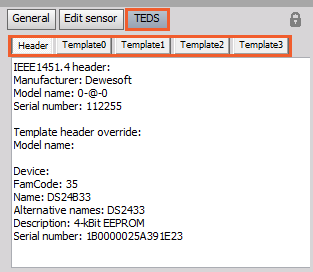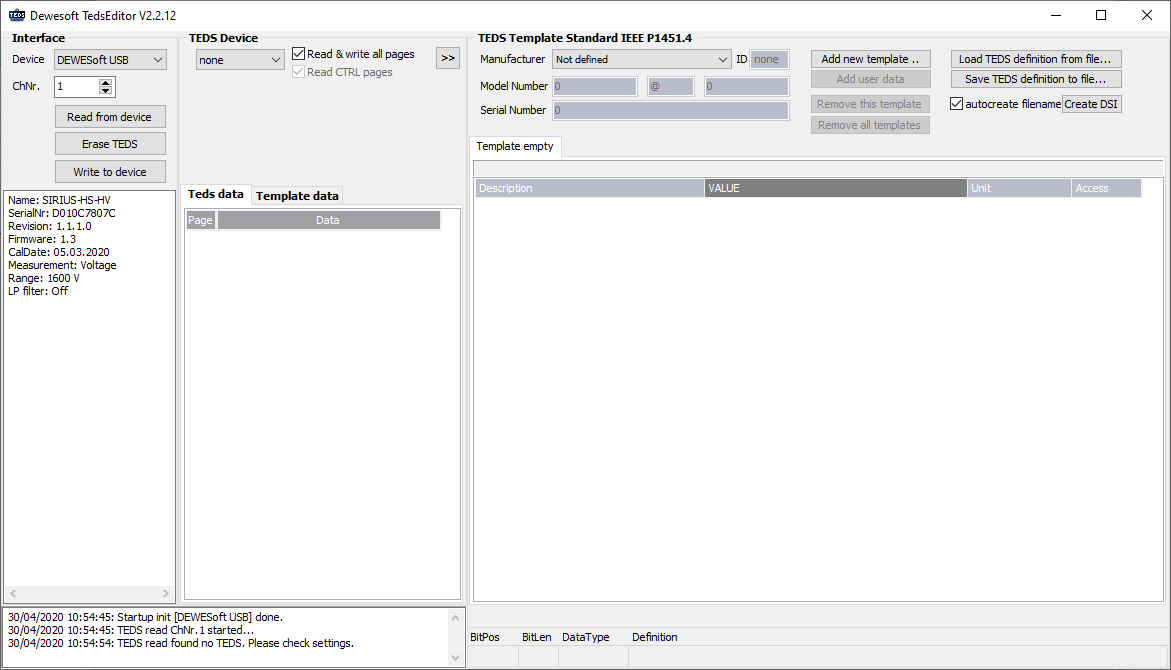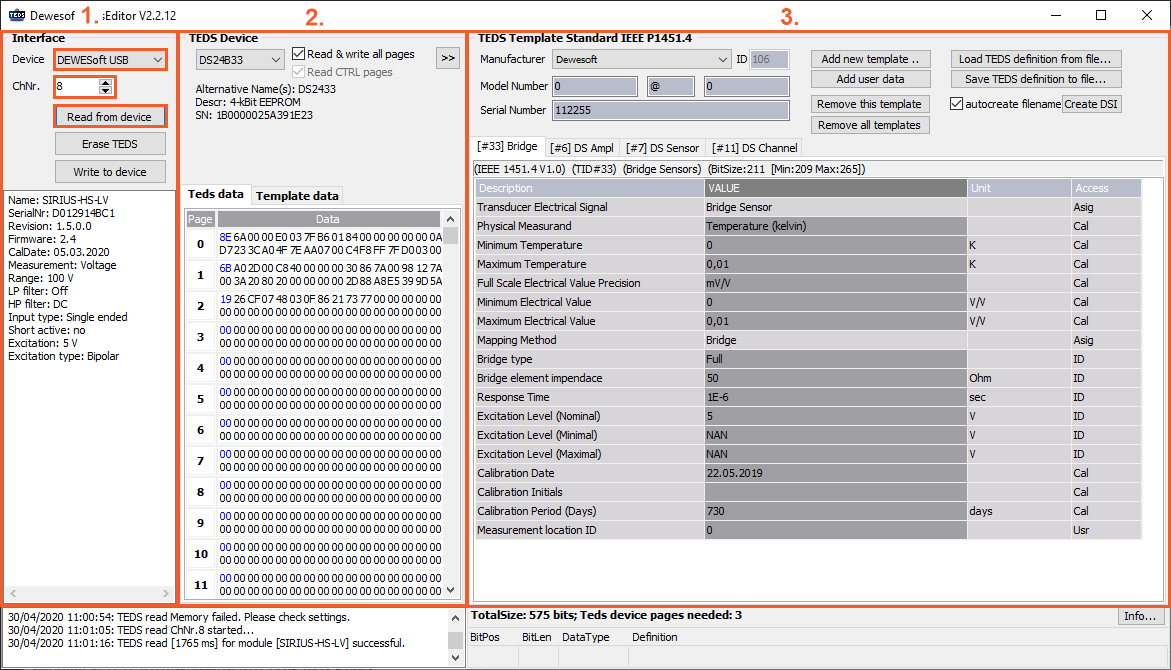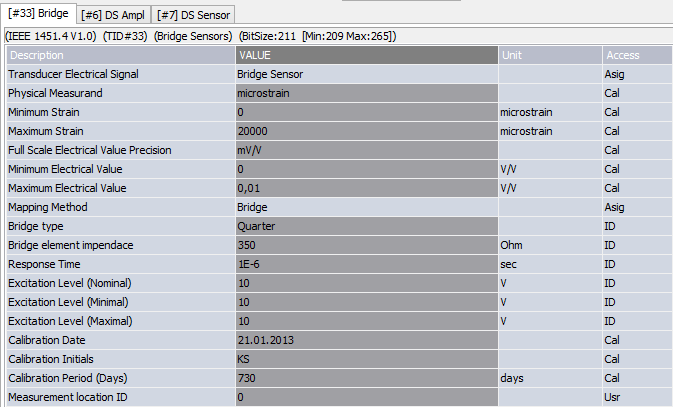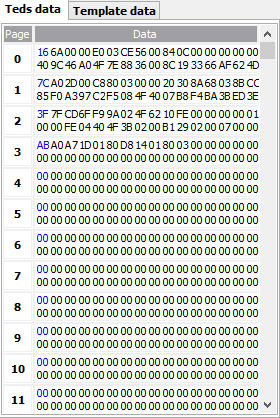TEDS editor is a complete tool for the management of TEDS chips. Even though we spent a lot of time developing it, it is completely free of charge. If you like it, we would be really happy if you make a donation to your local charity.
You don't even need a Dewesoft instrument to use DeweTEDSEditor, it works with low-cost OneWire Reader, so you can use it with your sensor calibration equipment to prepare sensors to work with Dewesoft or any other instrument supporting TEDS. The one we use as standard is a DS9490R USB based reader. It can be bough for around 20 USD.
You can find DeweTEDSEditor on our web page in the download section.
 Image 11: Dewesoft TEDS Editor interface
Image 11: Dewesoft TEDS Editor interface
After we Read from device, the screen gets filled with information from the sensor. Before reading from the device, select the right channel number on which you have connected TEDS.
 Image 12: Reading the TEDS chip from a sensor
Image 12: Reading the TEDS chip from a sensor
What we can see are three sections:
1. Interface,
2. TEDS device and
3. TEDS template.
1. Interface section
The left side is the Interface section and shows us the three Interfaces that Dewesoft allows to have - Dewesoft USB device, Amplifiers RS232, and OneWire reader.
 Image 13: Interface section
Image 13: Interface section
If we choose for example Dewesoft device in the Interface section, we also need to choose the right Channel number (ChNr.). And then we press Read from device.
On the left side we receive all the information of the amplifier or the interface: its name, serial number, calibration date, excitation, and more.
 Image 14: Information about the amplifier
Image 14: Information about the amplifier 2. TEDS device section
TEDS device section shows us what device was found after we have pressed Read from device. In our case it found a DS24B33 chip. This is also the usual TEDS that we recommend among all the different TEDS device options.
 Image 15: TEDS Device section
Image 15: TEDS Device section
 Image 16: Selecting TEDS Device
Image 16: Selecting TEDS Device
What we can see below the found TEDS device is also it's first (Alternative) name, short description, that shows us how many memory the TEDS has, in our example 4-kbit EEPROM and what is really unique - TEDS serial number (SN). On this point it is really important to point out that every TEDS chip has its own serial number.
3. TEDS template section
TEDS template section shows us the Manufacturer and his ID number, Model number and Serial number of TEDS. In this section we can also find detailed information, for example Bridge type, Response time,...
 Image 17: TEDS template section includes a lot of information
Image 17: TEDS template section includes a lot of information
All this information is decoded from TEDS Data on the left. After every change, Template data changes, and TEDS data stays the same as it was.
 Image 18: Decoded information from TEDS
Image 18: Decoded information from TEDS
Down at the bottom we can find all the actions that were made since we have opened the TEDS editor. All the errors will also appear in this screen.
 Image19: Actions made in TEDS editor
Image19: Actions made in TEDS editor
NOTE: Calibration date and other information of TEDS can be only changed if it was created by Dewesoft or if somebody else made it with the Dewesoft tool (TEDS editor).
IMPORTANT: While using the TEDS editor, you really need to know what you are doing!
Creating new TEDS sensors
Creating a TEDS sensor from scratch is very easy. First of all, we need to write in the Manufacturer, Model number and serial number. These fields are quite limited in what we can write in, but there is a better way of doing that, so if these fields don't make you happy, read further.
When you have an empty sensor, we can add a new template by pressing the Add new template button. All standard IEEE sensors are supported. We can enter any field in the template in the user editor.
 Image 20: Add a new template for an empty TEDS sensor
Image 20: Add a new template for an empty TEDS sensor
Now we can add additional templates. We can add a standard Calibration table, Calibration curve, or Frequency Response Curve or we can add the Dewesoft amplifier template to define all amplifier properties (Input type, Range, LP, and HP filter, ...).
 Image 21: Adding standard templates
Image 21: Adding standard templates
LP filter - defines which low pass filter will be chosen for the amplifier (advanced option has also type and filter order)
User coupling - defines which high pass filter will be used (either sensor is AC or DC coupled)
Measurement - defines which measurement type amplifier is set to (voltage, bridge, potentiometer, ...)
User excitation - defines the nominal excitation voltage the amplifier is set to by default
Input type - defines either amplifier is set to a differential or single-ended mode
User range - defines the range that the amplifier must be set to
Range dual-core - defines if high-dynamic dual-core ADC technology is used (related only to Dewesoft amplifiers)
We can also add Dewesoft sensor properties by adding the option to have a longer sensor description, serial number, limits, polarity, and so on.
 Image 22: Dewesoft sensor properties
Image 22: Dewesoft sensor properties
User manufacturer - this field overrides the manufacturer ID set in standard template
User model name - this field overrides the default model name (user can use alphanumeric characters of any length)
User serial number - this field overrides the default serial number (user can use alphanumeric characters of any length)
Physical measurand - defines which physical quantity sensor is measuring (according to SI unit system)
User scale - defines the sensor scale according to Dewesoft standard (so SI unit conversion can be used) - unit of measurement must comply to Dewesoft SI unit scheme
User Sensor Limits - defines the absolute minimum and maximum that sensor can measure (will be used for display purposes)
Additional bridge props - the properties for strain gage sensors not defined by the IEEE standard
Sensor polarity - defines standard sensor polarity
User Sensor offset changeable - if yes, user can change the offset at a later time (when setting up the initial load, for example)
User Sensor scale changeable - if yes, user can assign additional scale factor at a later time
Calibration info - additional info from calibration
We can also define a Dewesoft transfer curve template. This curve is used in frequency analysis to correct sensor frequency response as well as in the power module for example for current clamps sensor. We define the amplitude attenuation in % and the phase angle for a set of typical frequencies.
Once we are done defining the sensor, we can write it to the chip using Write to device button or save sensor for future use by using Save TEDS definition to file.
Dewesoft TEDS Library (TDL)
In the Dewesoft TEDS library we can find the description of how templates in TEDS editor work. With the use of this file, people should learn how to read all the information written in Dewesoft's templates. You can read all the data till the last bit, but no more than that.
You can download this text file DewesoftTEDSLibrary.zip from the download section on our Web page.











